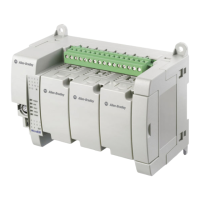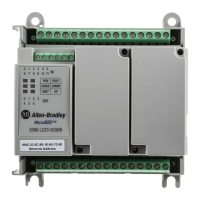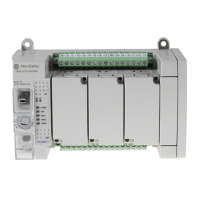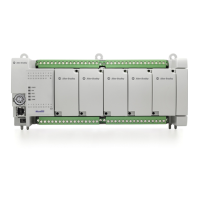Publication 1766-RM001A-EN-P - October 2008
Protocol Configuration 611
4. Can I take advantage of the SLC 5/03, 5/04 and 5/05
channel-to-channel passthru to remotely program the other SLC and
MicroLogix nodes using RSLinx and RSLogix 500/RSLogix Micro
running on a PC connected to a local SLC processor via DH+ or
Ethernet?
Yes, with certain limitations imposed based on the radio modem
network. Refer to the SLC 500 Instruction Set Reference Manual,
publication 1747-RM001, for more passthru details and limitations
when using the DF1 Radio Modem driver.
Modbus RTU Protocol
This section shows the configuration parameters for Modbus RTU (Remote
Terminal Unit transmission mode) protocol. For more information about
the Modbus RTU protocol, see the Modbus Protocol Specification
(available from http://www.modbus.org
).
The driver can be configured as Modbus RTU Master or Modbus RTU
Slave. The Modbus RTU Slave driver maps the four Modbus data types—
coils, contacts, input registers, and holding registers—into four binary
and/or integer data table files created by the user.
Modbus RTU Master
Message instructions are used to transfer information between the data
files in the Modbus RTU Master and the Modbus RTU Slaves. Refer to
Chapter 22 for detailed information about configuring a MSG instruction
for Modbus Communications.
Modbus addressing is limited to 16 bits per memory group, each with a
range of 1…65,536. There are four memory groups, one for each function:
• coils (generally addressed as 0xxxx)
• contacts (1xxxx)
• input registers (3xxxx)
• holding registers (4xxxx)
Coils and contacts are addressed at the bit level. Coils are like outputs and
can be read and written to. Contacts are like inputs and are read-only.
Input registers and holding registers are addressed at the word level.
Input registers are generally used for internally storing input values. They
are read-only. Holding registers are general purpose and can be both read
and written to.
efesotomasyon.com - Allen Bradley,Rockwell,plc,servo,drive

